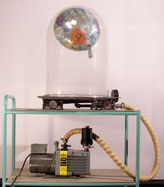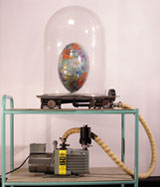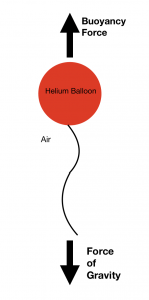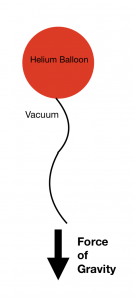This demonstration shows the Archimedes’ Principle applied to gases.
The helium balloon floats in air in a bell-jar. The balloon sinks when the air is removed from the jar by a vacuum pump (Figure 1,2).
Materials:
- Foil Helium Balloon
- Bell Jar
- Vacuum Pump
- Video Camera
Demo:
- Before the demonstration the foil balloon should be filled with just enough helium to float in a bell-jar filled with air (Figure 1).
- Turn on the vacuum pump.
- Turn off the pump as soon as the foil balloon begins to fall (Figure 2).
- Open the valve on the bell-jar and let the air in. The foil balloon will rise again.
Explanation:
Foil Balloon with Helium
Archimedes’ Principle states that an upward force, or a force that opposes gravity, acts on an object that is immersed, either partially or fully, in a fluid. This force is known as a buoyancy force , and it is equal to the weight of the fluid that is displaced by the object,
.
where g is the gravitational acceleration. Since the object has mass, it will also experience a force to due gravity ,. The object will hover at some height when the buoyancy force is equal to the force of gravity
If the buoyancy force is greater than the weight of the object, , the object will float in, or on, the fluid that it is immersed in. Since force is equal to mass times acceleration, this means if an object floats, it is lighter than the fluid it is floating in, or on.
It follows that $W_{fd} > W_{obj}$.
In this part of the demonstration, the balloon is filled with helium and it is placed in the bell-jar, which contains air. The helium balloon will float in this environment, since helium is lighter than air. This is shown in Figure 5.
The buoyancy force acting on the helium balloon due to the air will be greater than the weight of the helium balloon. When the vacuum is created, the air is taken out of the bell-jar. This leaves only the helium balloon inside of the bell-jar. Since there is no buoyancy force acting on the helium balloon, there is only the force of gravity, which causes the helium balloon to sink, or
This is shown in Figure 6.
Note:
- DO NOT use rubber balloons with helium because they will expand and explode in the bell-jar when air is pumped out. Use only self-sealing foil balloons.
- WATCH OUT for fluid coming from the vacuum pump that is heading to the vacuum chamber. Close the valve, so that the fluid does not enter the vacuum chamber.
- It is recommended that two people are present for this demo, in order to place the foil helium balloon inside of the large bell jar.
- Please give at least a 2 day notice, so that we could get the foil helium balloon prepared.
- This demo is restricted to lectures in Thimann 1 and Thimann 3 lecture halls.



